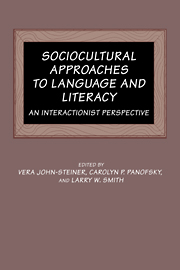Book contents
- Frontmatter
- Contents
- List of contributors
- 1 Introduction
- Part 1 Context
- Part II Mediational processes
- Part III Functional systems
- 11 Adults learning literacy: The role of private speech in reading comprehension
- 12 From “Paj Ntaub” to paragraphs: Perspectives on Hmong processes of composing
- 13 Toward a definition of law school readiness
- Author index
- Subject index
13 - Toward a definition of law school readiness
Published online by Cambridge University Press: 05 November 2011
- Frontmatter
- Contents
- List of contributors
- 1 Introduction
- Part 1 Context
- Part II Mediational processes
- Part III Functional systems
- 11 Adults learning literacy: The role of private speech in reading comprehension
- 12 From “Paj Ntaub” to paragraphs: Perspectives on Hmong processes of composing
- 13 Toward a definition of law school readiness
- Author index
- Subject index
Summary
PREFACE
Professions, like many other institutions, can be said to constitute distinct subcultures in society. That is, members of a profession share beliefs, values, norms, and special language concerning the world of experience the profession has made its domain. This chapter considers the legal profession in the context of an issue critical to the maintenance of any culture, namely, how its unique, defining properties are transmitted from one generation to the next. Specifically, the chapter examines current methods of socializing novices into the community of lawyers.
In the past, aspirants to a career in law learned their craft by apprenticing with practicing attorneys. Since approximately the turn of the century, however, schools of law have assumed an increasingly greater role in the education of lawyers. Moreover, the legal education process has become more formal and impersonal. Because law schools are now the primary transmitters of the culture of the legal profession, the inquiry here focuses on the content and pedagogy of law school programs.
Contemporary legal education provides a good medium in which to study the transmission of a professional culture, because contemporary legal education exhibits so dramatically the tension between change and stasis characteristic of intergenerational dynamics. Over the last 30 years, as women and members of ethnic minorities have been admitted to law schools in increasing numbers, the composition of the law student population has changed profoundly. In the face of these changes, law schools have retained traditional methods of teaching and performance expectations more appropriate to the exclusively white male student body of earlier years.
- Type
- Chapter
- Information
- Sociocultural Approaches to Language and LiteracyAn Interactionist Perspective, pp. 347 - 390Publisher: Cambridge University PressPrint publication year: 1994
- 4
- Cited by

